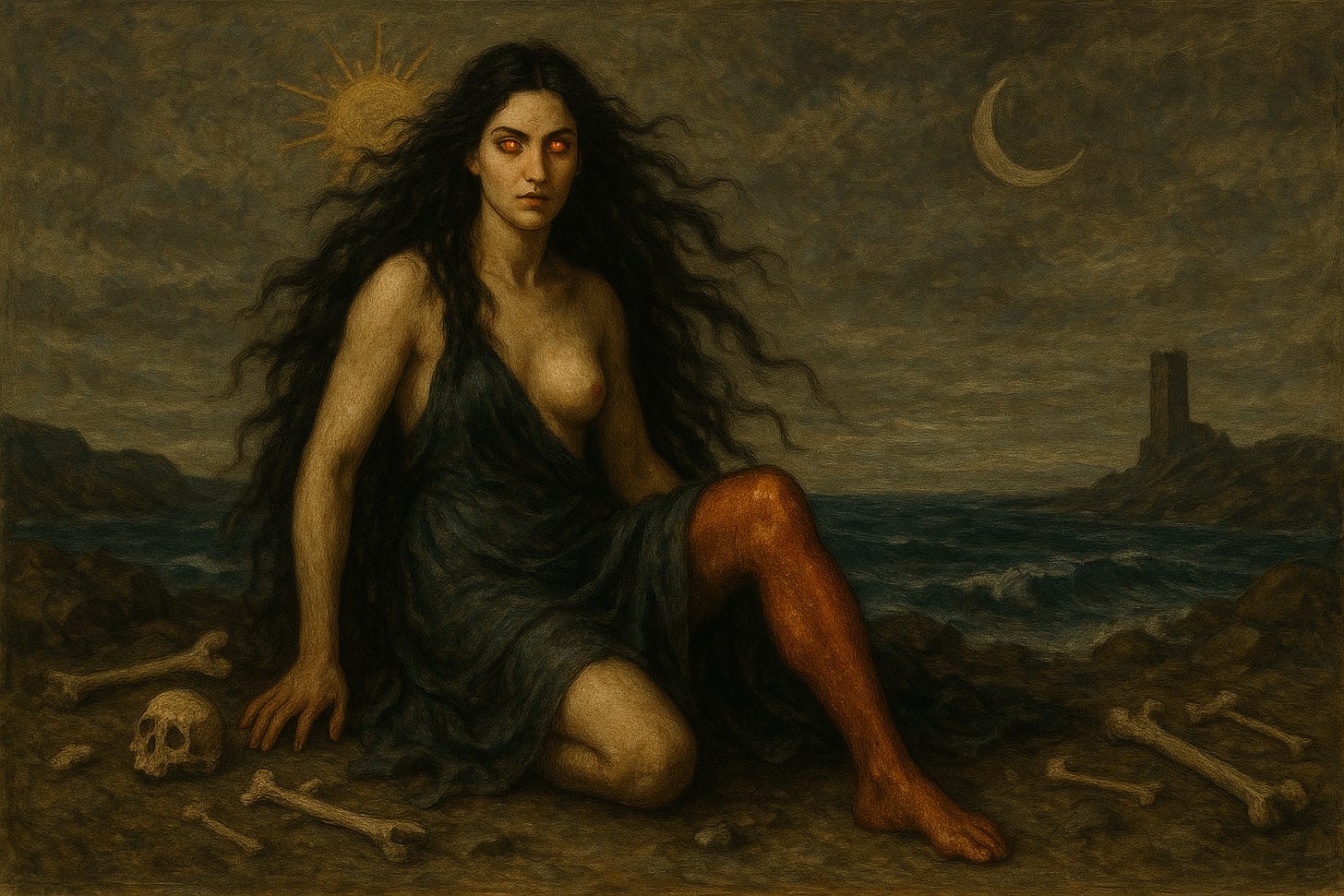[Corrected] By the Circuit of the Sun and the Horn of the Moon
Exorcising the she-demon with hairy heels and eyes of flame
Please note that as a long read, not all of this post will show up in your inbox. Just click on the “read more” link at the bottom to see the full post, or click here to view the full post in your browser.
Dear readers, sincere apologies for the snafu earlier today. I muddled my draft posts and sent out the wrong version. Sorry for clogging your inbox; I’ll avoid doing this again! Here is the correct, full version!
This is the follow-up piece to last week’s offering on Byzantine demonology in which I talked about the multiple syncretic female demons subsumed under the name of Gellō among others, and their deep sociocultural intersections. More on that here.
Below I unpack the detail of her legend, historiola, the origins of the other figures in these narratives and their variants. This is followed by a translation of the variants collected by Michael Psellos along with his commentary on this remarkably persistent tradition. This is the first complete English translation of the Gyllou-related sections of Michael Psellos’ On the Operations of Demons, based on Constantine Sathas’ 1896 edition. As always, there is a lengthy preview for free subscribers, while paid subscribers have full access.
About Gyllou (Gellō, Gillou)
Despite her roots in late antique demonology, it is in Greco-Byzantine folk belief that Gyllou/Gellō comes into her own, evolving into a prominent figure in Byzantine apotropaic traditions. Her attributes and descriptions are relatively stable, with variants found in specific regions: in all cases, she personifies the fears surrounding maternal mortality in childbirth and infant death.
Some of the earliest attestations of charms against Gyllou include the Kyranides, which recommend a hyena’s eyeballs or a bedsheet of ass’s skin.1 Other early variants call on the archangels to eliminate her,2 but as her legend became established in the Greco-Byzantine world, the legends, charms, and exorcisms relating to Gyllou became lengthier and crystallised into three fairly stable types of historiola.
The first is associated with some rather curious saints who figure nowhere else: Sisinnios, Sines, and Senodoros, brothers of Melitene, whose children Gyllou steals. The second features the Archangel Michael. In the third, the St. Mamas variant, another rich, persistent source of early Byzantine folklore with established pagan roots, she goes after livestock.
In all of them, she confesses under duress that she slays children out of envy. The saint or archangel forces her to list her deeds, names and forms in a classic magical trope intended to exert power over the demon. She is then forced to return the children, typically by vomiting them up, and is then made to swear an oath not to harm the individuals (also named) for whom the protective prayers or exorcisms are performed.
Twelve-and-a-half names
Forcing a demon to list its true names as a measure of disempowering it is a typical trope found in Jewish magic,and especially in the Testament of Solomon.3 In traditions featuring Abyzou, she is compelled to reveal her 40+ secret names by the Archangel Michael; the Gyllou legend reflects the same practice. While the number 12 is significant as a measure of completeness in various contexts (cosmic cycles, eg. zodiac signs), the half-name is particularly interesting.
Since demons will always exploit the smallest loophole, the addition of the half-name reflects “magical overflow,” an excess of protection is better than even a minor omission. This is also reflected in much later (19th-20th century) folktales featuring Gyllo, Lamia, and other demonesses: as the (horseriding) hero finally destroys her, he is warned to get rid of even her very smallest toenail or she will be able to reincarnate through it and return for vengeance (and usually he employs trusted dogs to do the job). Thus her naming is not only complete, but excessive, to emphasise the total dominance of whoever is asserting control over her.4
In the case of Gyllou, although her names differ from one variant to the next (also reflecting regional variations), the half name is often an epithet or group name - “Petomeni” (11th century) meaning “she who flies;” “Striggla” (16th century), is a descriptor for a whole class of supernatural beings. Particularly the variation in her many lists of names reflects the cultural syncretism at play, and assists in tracing the dissemination of the legend, while it also reflects precisely the routes through which such figures (eg. Gyllou, Lamia, Striggla, Avyzou) became syncretised as one demonness with many names.
Saint Sisinnios & variations
Saint Sisinnios (also spelled Sisinios, Sisinos, Sisennios, Sisinnius, or Sisennos) is not a canonical saint: he is a folk hero-saint appearing almost exclusively in magical charms and texts, exorcisms and amulets, for the spiritual defence of vulnerable women, children, and families against Gyllou, disease, or the evil eye. There is no canonical literature or vita associated with him anywhere in ecclesiastical literature; his legend and identity stem exclusively from apotropaic folklore and magical texts.
Keep reading with a 7-day free trial
Subscribe to Thyrathen: Greek Magic, Myth, and Folklore to keep reading this post and get 7 days of free access to the full post archives.





